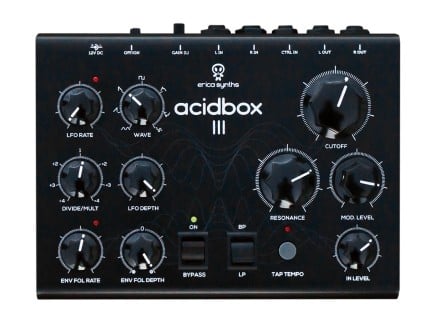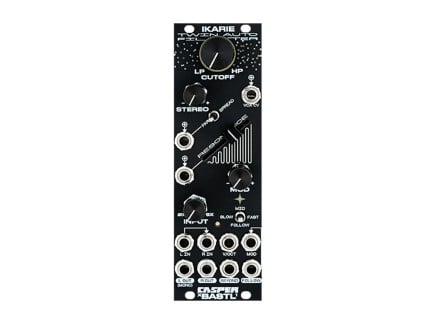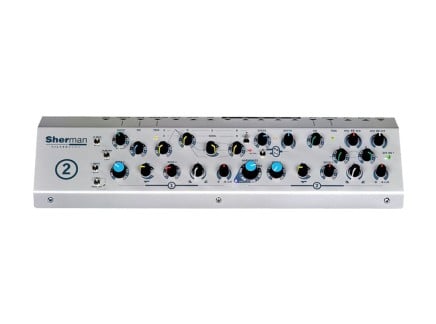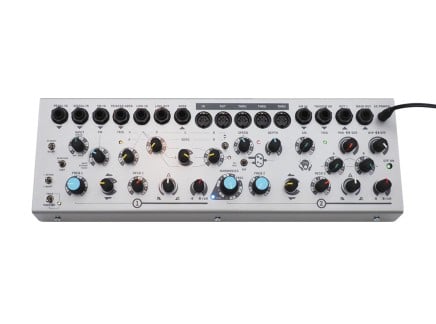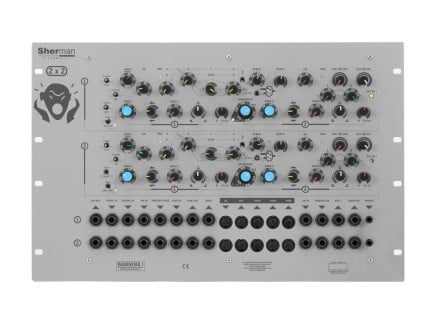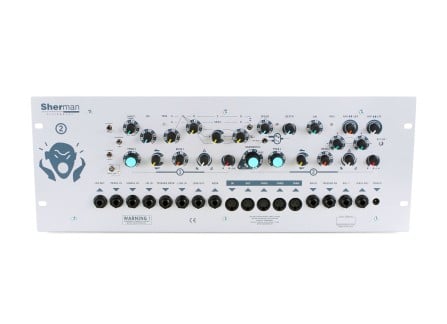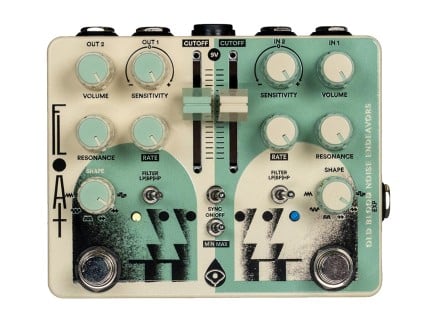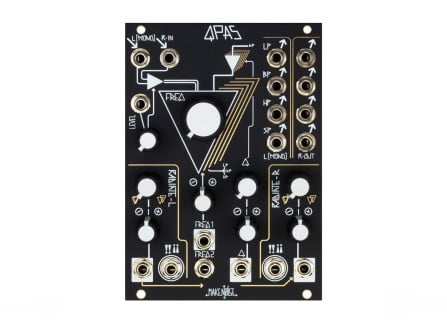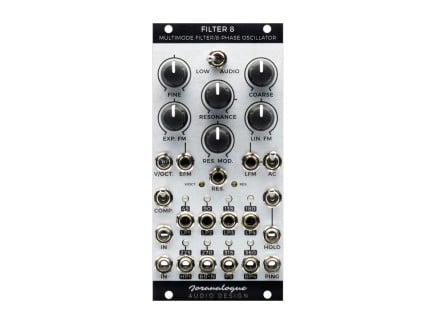It's no secret: if you ask a synth or electronic music production about their favorite tone-shaping tools, odds are they'll bring up their favorite filter. A filter is a way of shaping a sound's spectral content: allowing you a huge range of options for altering any sound's tone to turn it into something entirely new.
So, it's pretty easy easy to understand why filters are such significant musical tools. Many electronic instruments' character is dependent on their filters, from synthesizers and drum machines all the way to DJ mixers. A filter is where a simple sound/waveform turns into something broad, bassy, snarly, screechy, fizzy, liquid, and much more.
And of course, filters are useful outside the context of synthesizers: standalone filter units can be used at the center of any studio or performance setup, adding color to guitars, drum machines, submixes, and more. The thing is, because of how many filters there are out there in all formats, it can be difficult to pick out your favorite one.
So, we asked some of our pals to talk about their favorite filters in desktop/rack, pedal, and Eurorack format. So, in this article, we'll look at top picks from Dean Daughters from Electronisounds, Scott of Coma Tek, and Ross Fish from Moffenzeef—talking about the Erica Synths AcidBox III, the Bastl Ikarie, and the Sherman Filterbank 2, respectively. Let's dive in to learn more.
Dean's Pick: Erica Synths AcidBox III
Dean talked about the Erica Synths AcidBox III: and for good reason. The AcidBox III is based on Vladimir Kuzmin's filter design from the infamous Formanta Polivoks—a Soviet-era keyboard synthesizer famed for its aggressive, snarly, and surprisingly satisfying sound. AcidBox III packages the Polivoks filter in a desktop format, complete with stereo I/O, external CV input, internal LFO, internal envelope following, and more.
AcidBox III is a desktop-format filter designed for use with line level signals, making it a great pairing with standalone synthesizers, drum machines, or even reamp-ing situations with your DAW. It offers straightforward controls for input level, filter cutoff, and resonance, as well as a dedicated effect bypass switch. Like the original Polivoks filter, it operates in both lowpass and bandpass modes. With the resonance turned down, the lowpass mode is full and broad, and the bandpass mode offers everything from smooth sweeps to high-frequency fizz. Turn the resonance up, though, and the AcidBox will howl like a banshee: breaking down and turning into a dirty, aggressive onslaught of acid tones and self-oscillating madness.
Perhaps the most stand-out feature of the AcidBox is its robust internal modulation section. It includes an envelope follower, which allows you to use the loudness of your incoming sound to either open or to duck the filter's cutoff frequency, making it great for everything from auto-wah to pseudo-sidechained ducking sounds. The LFO offers sine, saw, ramp, square, triggered envelope, and stepped random shapes—and what's more, the LFO features a tap tempo control with associated clock divider/multiplier, making it dead simple to dial in rhythmic filter modulation of all sorts.
If you're looking for a tone-shaping tool for your standalone synths or drum machines, no doubt AcidBox III is one of the most robust and excellent-sounding desktop filters available. With a tone that goes from vast, weighty swells to insane screeching modulated burbles, gurgles, and FM'd groans, it's hard to imagine a setup that wouldn't gain something from having it around.
Scott's Pick: Bastl x Casper Ikarie
Next comes Scott's pick, the Bastl Instruments x Casper Electronics Ikarie twin auto filter...one of the most interesting Eurorack format filter modules currently available. In the Eurorack world, it takes a lot for a filter to stand out—frankly, there are too many of them—but Bastl's Ikarie is a favorite not only of Scott's, but of Perfect Circuit's as a whole. We love it...but why?
Ikarie represents a fusion of unrelated-yet-surprisingly-complementary aesthetics/design ideals for electronic music. On one hand, it's quite similar to the screeching and howling acid sounds you might get from a Roland TB-303 or its descendants; on the other, it's quite akin to the gurgling/burbling/uncannily vocal filtering methods found in the late Rob Hordijk's experimental instrument known as the Blippoo Box. Yet still, it's quite similar to the EQ-like filter/tilt controls used in DJ mixers to craft powerful tonal alterations with a single knob. And then, there's more: it also function in true stereo. This thing covers a lot of ground.
Ikarie has two audio inputs and two audio outputs, primarily designed for use in stereo filtering applications. It features a single cutoff knob, which continuously morphs from lowpass to highpass response (indicating influence from performance DJ mixers, as noted above). It offers two stereo modes—one which offers more straightforward panning via a dedicated stereo knob and CV input, and another which uses the knob and modulation input to offset the left and right filters' cutoff frequencies from one another; creating filter-based binaural panning effects difficult to achieve in other contexts. And of course, the resonance control is where much of the magic lies: taking Ikarie from big, broad sweeps all the way to glass-like pings and ringing to all-out acid self-oscillation screams. I love it.
But that's not where the tricks end. Ikarie also features an input gain control that makes it suitable not only for Eurorack-level signals, but for external instruments as well. Furthermore, it features a dedicated internal envelope follower which, like on the AcidBox above, can be used to create dynamic wah and ducking effects. Additionally, this envelope follower offers three speed ranges, for everything from snappy following to more sluggish, laggy behavior. For me, though, one of the most interesting aspects of Ikarie is the Beyond output, which uses both filters in order to create a variable-width bandpass response (much like the aforementioned Blippoo Box by Rob Hordijk, RIP). This mode is the source of Ikarie's potential for uncanny and frankly unsettling vocal timbres: a sonic trick that keeps me endlessly entertained.
With all of this packed into a mere 8hp of space, it's easy to imagine why Ikarie is so highly regarded among modular nerds: it's small, it's tremendously versatile, and it has a sonic character that stands out from nearly anything I've ever heard. If you have a Eurorack system and you're looking for a fun and inspiring filter, you should definitely check it out.
Ross's Pick: Sherman Filterbank
Lastly, we hear from Internet celebrity and connoisseur of only the finest instruments and audio processing methods, Ross Fish. You might know Ross as founder of internationally-acclaimed Moffenzeef, the savvy synth moguls who brought you one of the most significant studio secret weapons of the last decade: the Schtick. Or, if you're not in on the Schtick secret, you may know Ross as the proprietor of Moffentapes, who have released such modern classics as Passive Aggression on the Internet and Computer Music for Piano. What you might not know is that Ross is a lover of aggressive, mangled beats—including those aggressively mangled via the Sherman Filterbank 2 rack/desktop unit.
The Filterbank 2 is a modern cult classic dual filtering unit. It contains independent lowpass, bandpass, and highpass filters, which may operate in parallel or serial routing configurations. The second filter offers a six octave switch, which may be synchronized to the first filter for interlinked behavior. Additionally, it contains a host of options for modulation: an ADSR envelope generator which may be triggered via external signals for envelope follower-like behavior, as well as an LFO that goes well into the audio range. It also offers a built-in VCA with dedicated AR envelope, as well as a ring modulator input for RM'ing internal or external audio.
The filterbank also offers an extensive assortment of 1/4" control voltage inputs and outputs, making it easy to integrate with modular synthesizers, semi-modular synths, or CV-capable effect pedals. It also includes extensive MIDI connectivity, great for remotely controlling from your computer or hardware MIDI controller.
But looking at the Filterbank's features alone doesn't do it justice: you just have to hear it. Looking at a spec sheet alone might make it seem like it's a powerful selection of utilities—and in point of fact, it is—but it's also one of the most insane, disgusting, and brutal-sounding audio processors out there. While it'll definitely do clean, utility filtering, its strengths really lie in its extremes: extreme modulation rates, extreme distortion, and the unforgiving destruction of both what goes into it, as well as every dang eardrum within hearing distance. We say that with the utmost respect: if what you need is a powerful, no-nonsense, studio filter effect, it comes highly recommended. If what you need is an experimental modulation station for psychedelic audio experimentation, it's a perfect choice. And if what you need is an absolutely outrageous, unruly, and downright terrifying source of sonic mayhem, it's hard to recommend anything else above it.
The Filterbank is available in multiple formats: the original Filterbank 2, the Filterbank 2 Compact (a slimmed-down desktop filterbank), the Filterbank 2 Rack, and the unholiest of all: the Filterbank Dual Rack, a shrieking monstrosity of sonic destruction. The original and Compact models are both desktop-ready and rackmountable as well, so no matter your situation, there's a Filterbank for you.
Filtering Out the Noise
As you've seen, filters can take all forms: they can be soft and huge sounding, aggressive, biting, fizzy, dizzying, and downright peculiar. Moreover, they can come in any format...so whether you're a guitarist looking for a new pedal, a studio musician filling out your outboard gear selection, a modular enthusiast looking for new tones, or a musician in need of a desktop tone-shaping solution, there's a filter out there for you.
Be sure to check out our selection of modular synthesizer filters, filter effect pedals, and desktop filtering effects for a taste of everything else that's out there!

